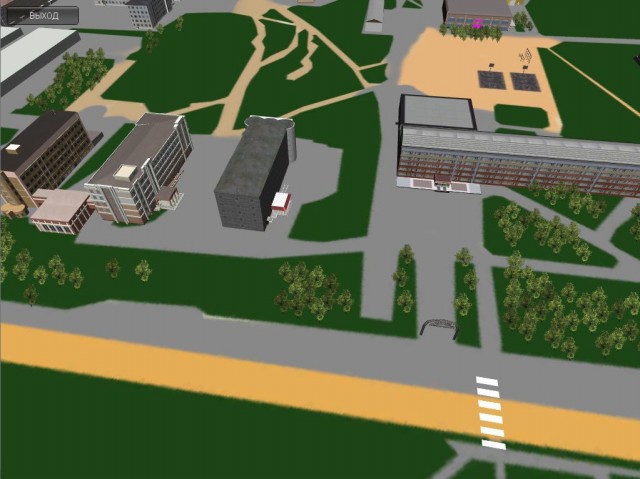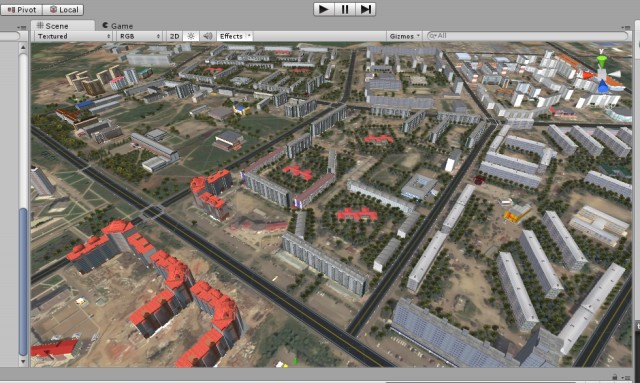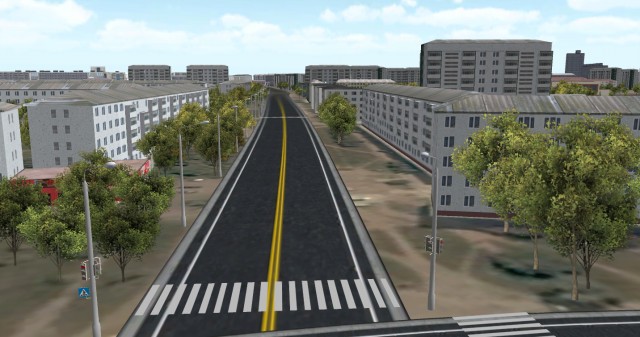3D GIS project of urban space
The origin of the project
At the beginning of 2014, the project of a realistic 3D GIS of our city began to develop in the SKB (student design office) of my university, which is engaged in development in the direction of 3D technologies. Such a loud name didn’t justify itself, since at that moment the prototype had only a 3D component and a substrate with a raster piece of Yandex.Maps. The application was created on the Unity game engine and contained a spatial navigation system around the 3D quarter of our university (Figure 1).

Figure 1 - One of the first screenshots of the project
The primary task was to create an array of realistic 3D models of buildings in one of the districts of the city. For this task, each participant of the special design bureau was allocated its own quarter, and the modeling conditions were not clearly defined, except that the model should be “easy”.
About data collection methods
I will make a small digression in which I will touch on the methods of studying buildings and collecting materials for subsequent modeling.
There was little experience in such matters, therefore, having armed myself with a camera, I took pictures of houses belonging to my future 3D quarter. Attempts to create photorealistic textures ended in failure, so the texture was created in a graphical editor using texture libraries of various materials (Figure 2).
')

Figure 2 - Example of early building model textures
I note that in the study of buildings, Yandex.Maps service is very helpful - 3D panoramas. He gives high-quality detailed photos of roadside buildings.
Next in the SKB
As a result of the work of eight people over the course of four months, eight quarters were created, respectively. I was not at all surprised by the result obtained by isolated people from each other, with little experience with 3D models. The main problem was in some bulky models of large-sized buildings that were executed in such detail that Unity caused FPS nerve twitches near such “monsters” (Figure 3).

Figure 3 - Example of processing detailed models
Me and my partner, not counting the project manager and the main collector, were under the blow of the diversity of the obtained 3D-models. We had to correct all the defects in eight blocks before they hit the map, so as not to spoil the karma.
The sore point of our 3D map was optimization, as I noted above - there were several places on the map where the FPS fell by two or even three times lower than the average value for the project as a whole. These problems were corrected by creating low-poly analogs of “heavy” models.
It took about four months of work to recycle heavy models, edit textures, scale and send the model assembly to Unity. Well, as the work, there were two of us, both students, employment in the SKB is incomplete. Therefore, the project completion dates were stretched to infinity, especially since no specific further goals were set.
Where is the GIS itself?
As you had time to notice from my story, the original project was planned as a 3D GIS, but there was no database, no binding to any coordinate system (geo-information).
It is worth noting that the prototype database of buildings was developed and tested by me. It represents the simplest information about the building and the binding of the camera to the center of the object with the effect of “searching” for the object by name.
As a substrate, a cut atlas of satellite Yandex.Maps is used, but in the initial versions a raster map drawing, a vector drawing and a map applied to the terrain were used. One of the problems of this method was the update of satellite images at the end of 2015, so the whole substrate will have to be redone. But there is an alternative. In the Asset Store, I came across the Google Maps for Unity plug-in, meaning it in an interactive Google upload. Map to the plane and not only. Unfortunately, the API version of this plugin is already outdated and therefore could not be used. There is an alternative to it, from the same developers, but already for $ 60.
Perspectives
Our project is frozen. We received a small incentive by winning a diploma with this project at the Innovation Youth Convention 2014. The city administration took a keen interest in our developments.
Fresh screenshots of the project



You can try out the online test version of the project at the following link:
3D map online
Guys, bought a premium account for hosting, now there will be no access problems! Thank you for your interest!)
Conclusion
I wanted to note that there are few articles about 3D GIS, in particular, there are commercial large projects that I did not consider in my article (Sity ENGINE, Infrastructure Modeler and others).
PS
Thank you for attention! I hope this topic is close to someone, I expect informative comments.I completely forgot - everyone can browse our article in the Electronic scientific publication "Scientists notes of PNU" at the following link: Scientific article - REALISTIC MODEL OF THE CITY SPACE
PS part two
Thanks for the comments comrades! I learned a lot of useful information for myself, I will explore Open Street Maps, in particular the Kendzi3D plugin for 3D buildings.
Source: https://habr.com/ru/post/249487/
All Articles